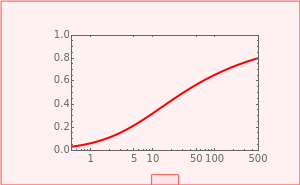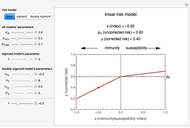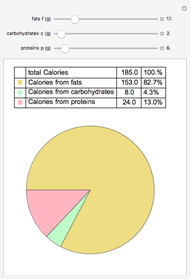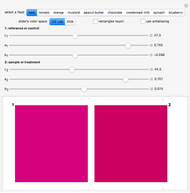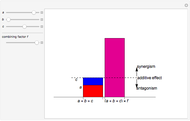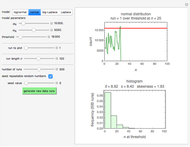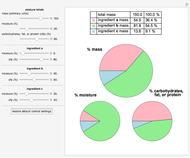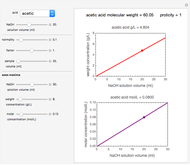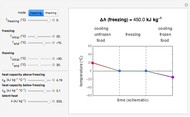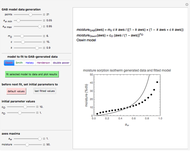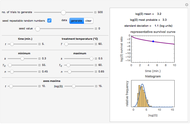Assessing the Risk of Food Poisoning

Requires a Wolfram Notebook System
Interact on desktop, mobile and cloud with the free Wolfram Player or other Wolfram Language products.
The probability of becoming sick or dying after ingesting a food-borne pathogen’s cells primarily depends on its virulence, the number of cells ingested, and the state of the person’s health. A dose-response-based model that incorporates the pathogen’s infective or lethal dose, its cells’ exponential growth rate, the growth duration, and an additive factor that represents an individual’s susceptibility or immunity is used to estimate this probability. Since the magnitudes of these factors are rarely if ever known exactly, they are entered as ranges. The acute poisoning probability is estimated by the expanded Fermi solution method, where random values formed within these ranges are used to calculate interim estimates in hundreds of Monte Carlo runs. The mode of the histogram of these interim estimates is considered the best estimate of the probability of poisoning.
Contributed by: Mark D. Normand and Micha Peleg (June 2014)
Open content licensed under CC BY-NC-SA
Snapshots
Details
Snapshot 1: a highly virulent organism after a short period of growth in a healthy person
Snapshot 2: a highly virulent organism after a short period of growth in a person having a compromised immune system
Snapshot 3: a milder virulent organism after a short period of growth in a person having a compromised immune system
Snapshot 4: a milder virulent organism after a long period of growth in a healthy person
This Demonstration presents an expanded Fermi solution method [1, 2] to estimate the probability of becoming sick or dying as a result of consuming food contaminated with a pathogenic bacterium. The method is based on a modified version of the beta-Poisson model of dose-response curves [3] where the "dose" (the number of ingested cells) is replaced by an exponential growth term to account for the pathogen’s ability to multiply in the food before its ingestion.
The pathogen's dose-response curve, which is displayed at the top, is a modified version of the beta-Poisson model [4]:  , where
, where  is the probability of being poisoned by ingesting
is the probability of being poisoned by ingesting  cells,
cells,  the number that will result in 50% infection, and
the number that will result in 50% infection, and  the pathogen's characteristic constant.
the pathogen's characteristic constant.
The combined model has two components: one  determined by the organism's dose-response curve and number of cells actually ingested, and the other determined by
determined by the organism's dose-response curve and number of cells actually ingested, and the other determined by  , (
, ( ), a parameter that accounts for the individual’s susceptibility or resistance to infection. The first component has the form:
), a parameter that accounts for the individual’s susceptibility or resistance to infection. The first component has the form:  , where
, where  is the initial number of cells,
is the initial number of cells,  the growth time (e.g. in hours or days) starting from incomplete cooking, for example, and
the growth time (e.g. in hours or days) starting from incomplete cooking, for example, and  a characteristic exponential growth rate constant in the corresponding units. Where
a characteristic exponential growth rate constant in the corresponding units. Where  (indicating susceptibility), the poisoning probability rises, and where
(indicating susceptibility), the poisoning probability rises, and where  (indicating resistance), it is lowered. According to the combined model, the food poisoning probability
(indicating resistance), it is lowered. According to the combined model, the food poisoning probability  is given by the following: if
is given by the following: if  , then
, then  and otherwise
and otherwise  .
.
Since  ,
,  ,
,  ,
,  ,
,  , and
, and  are rarely if ever known exactly, they are identified by the upper and lower limits of their probable ranges, set by sliders. Random parameter values from within their respective ranges are then used to compute
are rarely if ever known exactly, they are identified by the upper and lower limits of their probable ranges, set by sliders. Random parameter values from within their respective ranges are then used to compute  estimates repeatedly using the above equation as a model. The actual number of runs is selected with a slider and so is the seed, if desired. The histogram of these interim estimates is calculated and displayed. The interim value having the highest frequency is considered the best estimate of poisoning probability for the entered parameter settings. Its numerical value is displayed in blue accompanied by the histogram’s mean and standard deviation.
estimates repeatedly using the above equation as a model. The actual number of runs is selected with a slider and so is the seed, if desired. The histogram of these interim estimates is calculated and displayed. The interim value having the highest frequency is considered the best estimate of poisoning probability for the entered parameter settings. Its numerical value is displayed in blue accompanied by the histogram’s mean and standard deviation.
The main objective of the Demonstration is to illustrate the expanded Fermi solution method’s potential use in calculating the probability of sickness or death as a result of food poisoning. Since it has not been intended to estimate the risk of any particular pathogen, not all the parameter combinations that the Demonstration allows necessarily have a real-life counterpart.
References
[1] M. Peleg, M. D. Normand, J. Horowitz, and M. G. Corradini, "Expanded Fermi Solution for Estimating the Survival of Ingested Pathogenic and Probiotic Microbial Cells and Spores," Applied and Environmental Microbiology, 77, 2011 pp. 312–319.
[2] M. Peleg, M. D. Normand, and M. G. Corradini, "Construction of Food and Water Borne Pathogens' Dose-Response Curves Using the Expanded Fermi Solution," Journal of Food Science, 76, 2011 pp. R82–R89.
[3] D. L. Holcomb, M. A. Smith, G. O. Ware, Y.-C. Hung, R. E. Brackett, and M. P. Doyle, "Comparison of Six Dose-Response Models for Use with Food-Borne Pathogens," Risk Analysis, 19(6), 1999 pp. 1091–1099.
[4] "Dose Response Assessment." Quantitative Microbial Risk Assessment (QMRA) Wiki. (Jan 16, 2013) qmrawiki.msu.edu/index.php?title=Dose_response_assessment.
Permanent Citation


